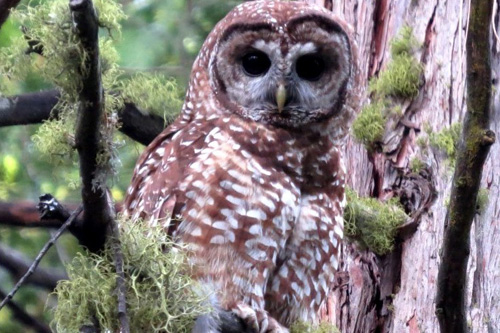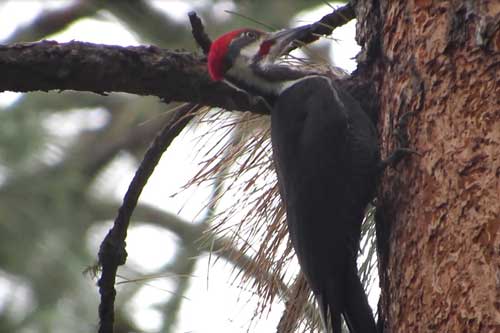I know Maya Khosla from when she was a presenter at the Mendocino Coast Writers Conference a number of years ago. Last week, a mutual friend sent this blog post of Maya's. I contacted her and asked to reprint it. It's been driving me nuts that every newscast about the fires here in California, and elsewhere, all refer how many acres have been "destroyed." Houses, businesses, and lives can be destroyed, but given time, the land rebounds, and there are native species that thrive after a fire. I hope you'll take the time to read this. It will give you a new perspective on wild land fires.
By Maya Khosla, posted on April 25, 2016
Fire Works
How valuable are forests of the American West that have
experienced wildfire? With over 10 million acres that burned across the
region in 2015, that question has sharply gained in prominence. Many of
us understand that an average of 30 million acres burned annually in
wildfires of the 1920s and 1930s – and acreages were even higher during
prior decades (according to U.S. Forest Service records).
Even so, the
sheer power of today’s visuals often pose a challenge in accepting that
wildfires – with all their natural variables including low, medium and
high severity – have been an integral part of western ecosystems for
eons.
 |
|
Rim fire spotted owl. Credit: Maya Khosla
|
The curious conservation biologist who hikes through post-fire
forests will inevitably be rewarded with a number of sights that attest
to their high ecological value. A more focused way to understand the
forests is to venture out in search of rare birds. In 2014 and 2015,
teams of biologists worked on protocol surveys to quantify the nest
density of black-backed woodpeckers, which are increasingly rare in the
Sierra Nevada-Cascades Region. With their glossy black backs, the
woodpeckers are ideally equipped to live in burned forests abundant with
high densities of snags (standing dead trees), each of which quickly
grows rich with wood-boring beetle larvae – the woodpeckers’ preferred
food source. Also colonized by bark beetle larvae, the “snag forests”
support Lewis’s, pileated, hairy and white-headed woodpeckers,
sapsuckers, northern flickers, nuthatches, an astonishing bustle of
wildflowers, buzzing insects, song birds and other wildlife including
deer, bears, and even Pacific fishers. Mornings are little short of
dazzling.
The teams of biologists who began their surveys in 2014 were led by
Dr. Chad Hanson (Director, John Muir Project of Earth Island Institute)
and senior biologist Tonja Chi. For a thorough study, both burned and
unburned forest plots were randomly selected across national forests of
the Sierra Nevadas. Surveys were conducted in triplicate, within
300-hectare plots. Each plot contained three 100-hectare subplots,
making it convenient for three biologists to survey one subplot at a
time.
 |
|
Black-backed woodpecker.
|
Preliminary results indicate that nesting black-backed woodpeckers
are found almost exclusively in recently burned forests. The woodpeckers
are also found in unburned, “beetle kill” forests (with snags that are
abundant with beetle larvae). In both forests, the common denominator
for black-backed woodpeckers is high densities of snags. True to their
reputation as keystone species, the woodpeckers provide nests for a host
of other birds including mountain bluebirds, western bluebirds, wrens,
nuthatches, mountain chickadees and even for squirrels. During the 2015
surveys, team members also documented other rare birds in the post-fire
forests, including the northern goshawk, California spotted owls, and
Williamson's sapsucker – all in post-fire forests.
These forests typically include areas that have burned with high
severity (where most trees turn into snags), moderate severity (anywhere
between one quarter and three quarters of the trees had turned into
snags) and low severity (where it’s mostly the understory that has
burned). While fires may scorch large patches, many trees charred by the
flames remain alive at the crown. They flush with new growth soon after
the burn. However, post-fire forests are still misunderstood and
routinely logged, so they are highly threatened habitats.
 |
|
Pileated woodpecker
|
According to many experts, fire and black-backed woodpeckers are
inextricably linked. The long-term black-backed woodpecker study will
continue through the 2016 field season and is anticipated to corroborate
results of existing data from other sources, and to provide valuable
data about the woodpecker’s habitat uses. Solid estimates of the Sierra
Nevada-Cascades population of black-backed woodpeckers are also
expected to result from the study.
Many other observations are revealing the high value of post-fire
forests. A year after the King Fire in El Dorado National Forest,
carpets of conifer seedlings were observed rising from the ashes along
with three rare plants. One of them, the longfruit jewelflower (first
described by Glen Clifton and Roy Buck in 2007), had never been sighted
in El Dorado before. Two years after the 2013 Rim Fire in Yosemite
National Park and the Stanislaus National Forest, vast areas with mature
pines that were presumed dead had bounced back to life. Seedlings were
popping up everywhere in the high-intensity burn areas.
Authors Jon Keeley and others demystify the abundance of
regenerating plants by explaining the “fire-generated chemical stimulus
for germination” found in many plant families.” An exciting new book,
The Ecological Importance of Mixed-Severity Fires: Nature’s Phoenix
(edited by Dominick DellaSalla and Chad Hanson), gives us dozens of
examples of the high biodiversity found in post-fire forests, and an
ever-increasing number of studies are speaking reams about the value of
forests after wildfire.
Author Bio

Maya is a biologist and writer who worked with the
black-backed woodpecker team in 2014 and filmed them in 2015. She has
written Web of Water: Life in Redwood Creek and Notes from the Field
(Golden Gate Parks Conservancy Press); Tapping the Fire, Turning the
Steam: Securing the Future with Geothermal Energy (World Wide Fund for
Nature); Heart of the Tearing: Poems (Red Dust Press); and Keel Bone
(Dorothy Brunsman Poetry Prize; Bear Star Press). She has received
writing awards from Flyway Journal, Headlands Center for the Arts,
Hedgebrook Foundation, and Ludwig Vogelstein Foundation and filming
awards from Patagonia, Sacramento Audubon Society (for the Searching for
Gold Spot project) and the Save Our Seas Foundation (For the Turtle
Diaries project).
 It drives me crazy to ask for water in a restaurant and have it come with a slice of lemon in it. When I order water, friends, in unison, will add "NO LEMON!" before I can. I know. In the scheme of all that can go wrong in one's life, this is silly. There are floods, fires, earthquakes, Zika, the Presidential campaign, what the hell is the big deal about a lovely slice of lemon in an icy glass of water?
It drives me crazy to ask for water in a restaurant and have it come with a slice of lemon in it. When I order water, friends, in unison, will add "NO LEMON!" before I can. I know. In the scheme of all that can go wrong in one's life, this is silly. There are floods, fires, earthquakes, Zika, the Presidential campaign, what the hell is the big deal about a lovely slice of lemon in an icy glass of water?



